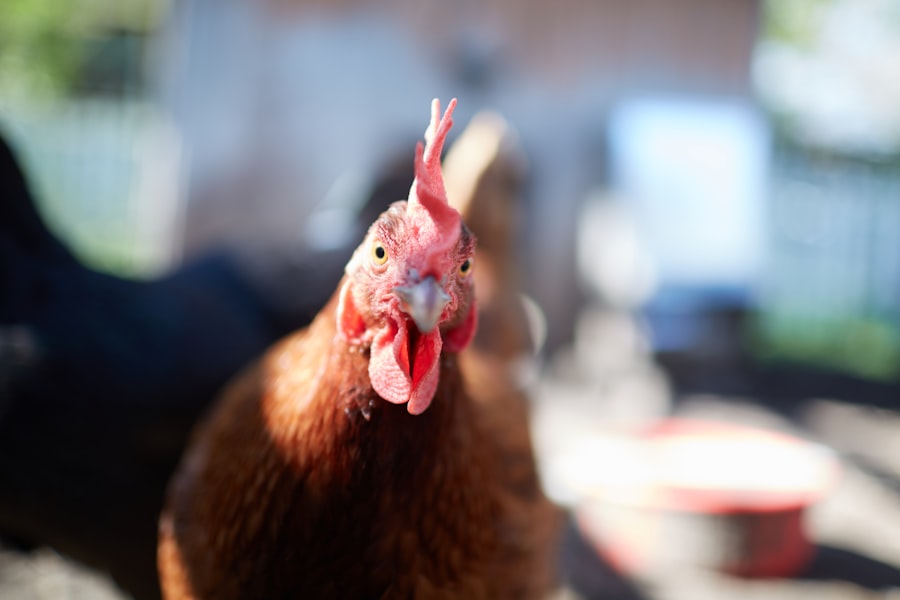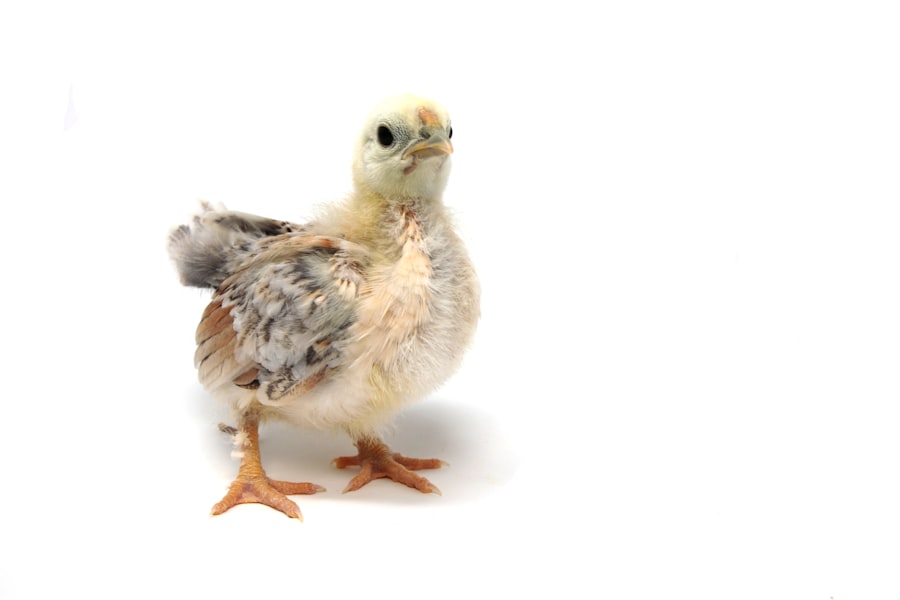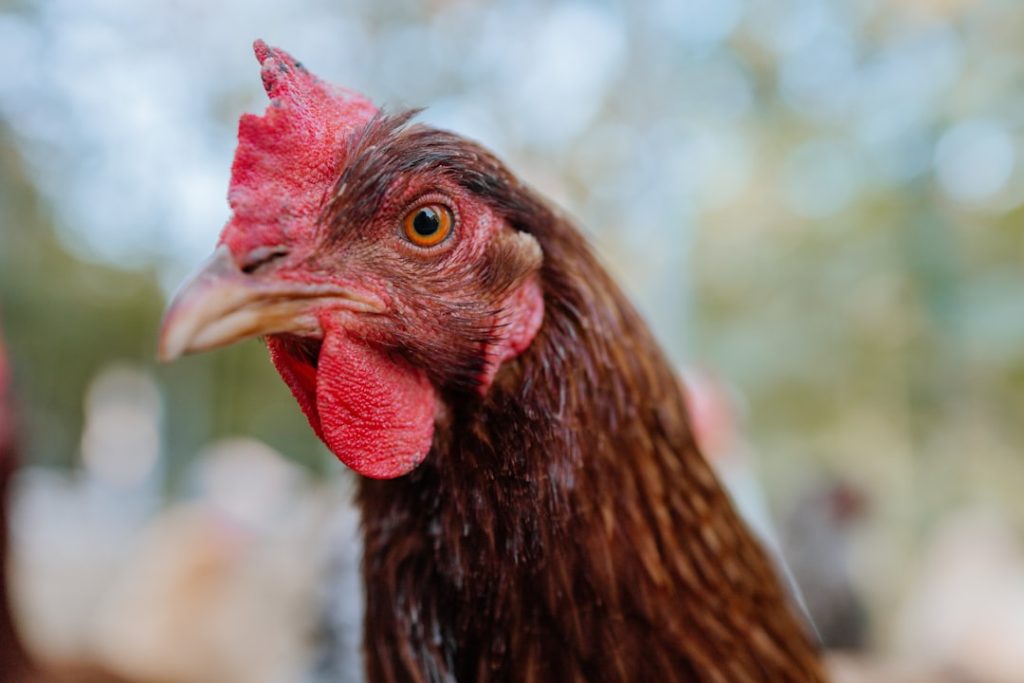Chicken beaks are essential components of avian anatomy, serving multiple functions including foraging, grooming, and defense. These specialized structures enable chickens to peck at food, manipulate small objects, and communicate with other birds. A comprehensive understanding of chicken beak anatomy and growth patterns is crucial for effective poultry care and management.
The chicken beak consists of two main parts: the upper mandible and the lower mandible. Both are covered by a hard, keratinous layer called the rhamphotheca, which continuously grows throughout the bird’s life. The beak’s interior contains blood vessels, nerves, and sensory receptors that aid in feeding and environmental perception.
Beak growth in chickens is influenced by various factors, including genetics, nutrition, and environmental conditions. Proper nutrition, particularly adequate levels of calcium and vitamin D, is essential for healthy beak development. Environmental factors such as lighting and temperature can also impact beak growth rates.
Regular beak maintenance is vital for chicken health and welfare. In commercial poultry operations, beak trimming is sometimes practiced to prevent feather pecking and cannibalism. However, this procedure is controversial and subject to animal welfare concerns.
Alternative management strategies, such as environmental enrichment and proper nutrition, can help mitigate behavioral issues without resorting to beak trimming. Monitoring beak health is an important aspect of chicken care. Signs of beak abnormalities or diseases should be promptly addressed by a veterinarian.
Providing appropriate substrates for foraging and pecking can help maintain natural beak wear and prevent overgrowth. In conclusion, a thorough understanding of chicken beak anatomy, growth patterns, and maintenance is essential for optimal poultry health and productivity. By implementing proper management practices and addressing potential issues promptly, poultry keepers can ensure the well-being of their flock and promote healthy beak development.
Table of Contents
- 1 Anatomy of a Chicken Beak
- 2 Do Chicken Beaks Keep Growing?
- 3 Factors Affecting Beak Growth
- 4 Importance of Beak Maintenance for Chickens
- 5 How to Manage Beak Growth in Chickens
- 5.1 Managing Beak Growth in Chickens
Proper care, nutrition, and environmental conditions are essential for supporting healthy beak growth in chickens. A balanced diet that includes essential nutrients such as protein, vitamins, and minerals is crucial for overall health and development.
- 5.2 Environmental Conditions
- 5.3 Enrichment and Maintenance
- 5.1 Managing Beak Growth in Chickens
- 6 Conclusion and Final Thoughts
- 7 FAQs
Key Takeaways
- Chicken beaks are essential for their survival and play a crucial role in their daily activities such as eating, drinking, and grooming.
- The anatomy of a chicken beak consists of the upper and lower mandibles, which are made of keratin and can vary in size and shape depending on the breed of the chicken.
- Contrary to popular belief, chicken beaks do not keep growing throughout their lifetime and instead reach a certain length and then stop growing.
- Factors such as genetics, diet, and environmental conditions can affect the growth and maintenance of chicken beaks.
- Proper beak maintenance is important for chickens to ensure their overall health and well-being, and it can be managed through various methods such as providing appropriate feed and environmental enrichment.
Anatomy of a Chicken Beak
Structure and Function
The beak of a chicken is a complex structure composed of several components, including the upper and lower mandibles, nostrils, and tongue. The upper mandible is the curved, pointed part of the beak used for pecking and picking up food, while the lower mandible is the shorter, more rounded part that helps the chicken grasp and manipulate objects. The nostrils, located at the base of the beak, allow chickens to breathe while foraging and are also used for olfactory communication.
Composition and Growth
The beak is made of keratin, the same material found in human fingernails and hair, which makes it strong and durable. Additionally, the beak is constantly growing and regenerating, allowing chickens to maintain their beak structure throughout their lives.
The beak contains a network of blood vessels and nerves that provide sensation and blood supply to the beak, allowing chickens to have a keen sense of touch and temperature regulation through their beaks. The beak is also an important tool for social interactions among chickens, as they use it to establish dominance, communicate with each other, and even engage in grooming behaviors.
Overall, the anatomy of a chicken’s beak is a fascinating and intricate system that plays a vital role in their daily activities and overall well-being.
Do Chicken Beaks Keep Growing?

Yes, chicken beaks do continue to grow throughout their lives. The growth of a chicken’s beak is a natural process that allows them to maintain their beak structure and function. The constant growth of the beak is necessary because it can become worn down from pecking at hard surfaces, picking up objects, and grooming activities.
As the beak grows, the outer layer of keratin is gradually worn down, revealing the newer layers underneath. This process helps to keep the beak sharp and functional for various tasks such as foraging for food, preening feathers, and defending against predators. The rate of beak growth can vary among individual chickens and can be influenced by factors such as genetics, diet, environmental conditions, and overall health.
Some chickens may have faster or slower beak growth rates compared to others, which can impact their ability to maintain their beak structure. Additionally, certain breeds of chickens may have different beak growth patterns due to their genetic makeup. It is important for poultry owners to monitor the growth of their chickens’ beaks regularly to ensure that they are growing at a healthy rate and are not experiencing any abnormalities or issues with their beaks.
Factors Affecting Beak Growth
Several factors can influence the growth of a chicken’s beak, including genetics, diet, environmental conditions, and overall health. Genetics play a significant role in determining the growth patterns of a chicken’s beak, as certain breeds may have genetic predispositions for faster or slower beak growth rates. Additionally, individual variations within a breed can also impact how quickly a chicken’s beak grows.
Diet is another crucial factor that can affect beak growth, as chickens require a balanced diet rich in essential nutrients such as protein, vitamins, and minerals to support healthy beak development. A lack of proper nutrition can lead to stunted or abnormal beak growth in chickens. Environmental conditions can also play a role in beak growth, as exposure to extreme temperatures or harsh living conditions can impact the overall health and development of a chicken’s beak.
For example, excessively dry or abrasive bedding materials can cause excessive wear on a chicken’s beak, leading to abnormal growth patterns or even injury. Lastly, the overall health of a chicken can influence its beak growth, as underlying health issues or diseases can affect the bird’s ability to maintain its beak structure. It is important for poultry owners to provide a suitable environment and proper nutrition for their chickens to support healthy beak growth and development.
Importance of Beak Maintenance for Chickens
Beak maintenance is crucial for the overall health and well-being of chickens. A properly maintained beak allows chickens to engage in essential activities such as foraging for food, grooming their feathers, and defending themselves against predators. Regular pecking and picking at objects can cause wear on a chicken’s beak, which is why it is important for their beaks to continue growing to replace the worn-down layers of keratin.
Without proper maintenance, chickens may experience difficulties in feeding, preening, and other essential behaviors. In addition to functional purposes, beak maintenance is also important for social interactions among chickens. A well-maintained beak allows chickens to communicate effectively with each other through pecking behaviors and vocalizations.
It also plays a role in establishing social hierarchies within flocks and maintaining order among the birds. Furthermore, proper beak maintenance can help prevent behavioral issues such as feather pecking and aggression within flocks. Overall, ensuring that chickens have healthy and well-maintained beaks is essential for their overall welfare and quality of life.
How to Manage Beak Growth in Chickens

Managing Beak Growth in Chickens
Proper care, nutrition, and environmental conditions are essential for supporting healthy beak growth in chickens. A balanced diet that includes essential nutrients such as protein, vitamins, and minerals is crucial for overall health and development.
Nutrition and Hydration
Providing access to clean water at all times is vital for proper hydration, which is necessary for maintaining healthy beak growth. A well-balanced diet that meets the nutritional needs of chickens is also essential for supporting healthy beak development.
Environmental Conditions
Suitable living conditions with comfortable bedding materials and adequate space can help prevent excessive wear on a chicken’s beak. Regular monitoring of a chicken’s beak growth is also important for managing their overall health and well-being.
Enrichment and Maintenance
Providing enrichment activities such as pecking toys or natural foraging opportunities can help promote healthy beak maintenance in chickens. Regular inspections of a chicken’s beak for any signs of abnormal growth or wear are also necessary, and veterinary care should be sought if any issues are identified. By providing a supportive environment and proper care, poultry owners can help ensure that their chickens maintain healthy and functional beaks throughout their lives.
Conclusion and Final Thoughts
In conclusion, understanding the anatomy and growth patterns of chicken beaks is essential for proper care and management of these birds. Chicken beaks are complex structures that serve multiple purposes such as foraging, grooming, and social interactions. The constant growth of a chicken’s beak allows them to maintain their beak structure throughout their lives by replacing worn-down layers of keratin.
Factors such as genetics, diet, environmental conditions, and overall health can influence the growth patterns of a chicken’s beak. Proper maintenance of a chicken’s beak is crucial for their overall health and well-being, as it allows them to engage in essential activities such as feeding, grooming, and social interactions. Poultry owners can help manage beak growth by providing a balanced diet, suitable living conditions, regular monitoring, and enrichment activities for their chickens.
By taking proactive measures to support healthy beak development in chickens, poultry owners can ensure that their birds have the best possible quality of life.
If you’re interested in learning more about keeping chickens, you may want to check out this article on chicken coop design in Muskegon. It provides valuable information on creating a comfortable and functional living space for your feathered friends.
FAQs
Do chickens beaks keep growing?
Yes, a chicken’s beak does continue to grow throughout its life.
Why do chickens’ beaks keep growing?
Chickens’ beaks are made of keratin, the same material as human fingernails and hair, which continues to grow throughout their lives.
How do chickens keep their beaks from becoming too long?
Chickens naturally wear down their beaks through pecking at the ground, scratching, and eating.
Can chickens’ beaks become overgrown?
Yes, in some cases, a chicken’s beak can become overgrown if it is not able to naturally wear it down through normal activities.
What can be done if a chicken’s beak becomes overgrown?
If a chicken’s beak becomes overgrown, it may need to be trimmed by a veterinarian or experienced poultry handler to prevent any issues with eating or drinking.

Meet Walter, the feathered-friend fanatic of Florida! Nestled in the sunshine state, Walter struts through life with his feathered companions, clucking his way to happiness. With a coop that’s fancier than a five-star hotel, he’s the Don Juan of the chicken world. When he’s not teaching his hens to do the cha-cha, you’ll find him in a heated debate with his prized rooster, Sir Clucks-a-Lot. Walter’s poultry passion is no yolk; he’s the sunny-side-up guy you never knew you needed in your flock of friends!
Meet Walter, the feathered-friend fanatic of Florida! Nestled in the sunshine state, Walter struts through life with his feathered companions, clucking his way to happiness. With a coop that’s fancier than a five-star hotel, he’s the Don Juan of the chicken world. When he’s not teaching his hens to do the cha-cha, you’ll find him in a heated debate with his prized rooster, Sir Clucks-a-Lot. Walter’s poultry passion is no yolk; he’s the sunny-side-up guy you never knew you needed in your flock of friends!







